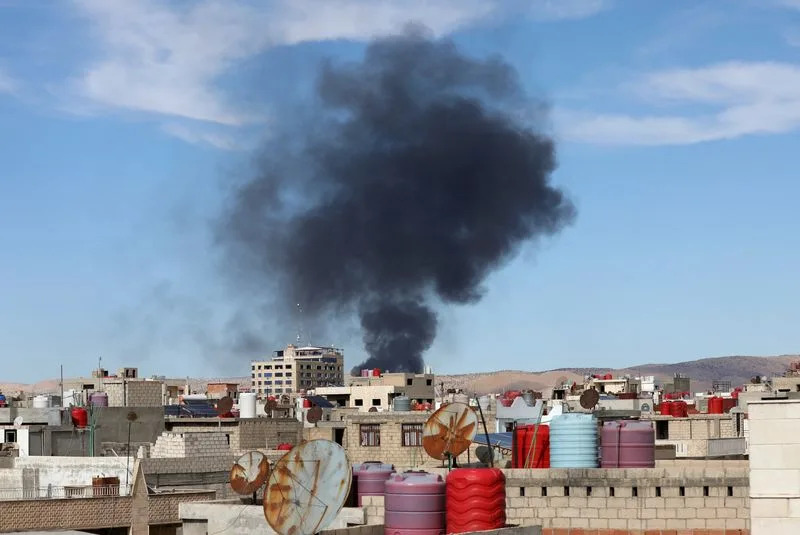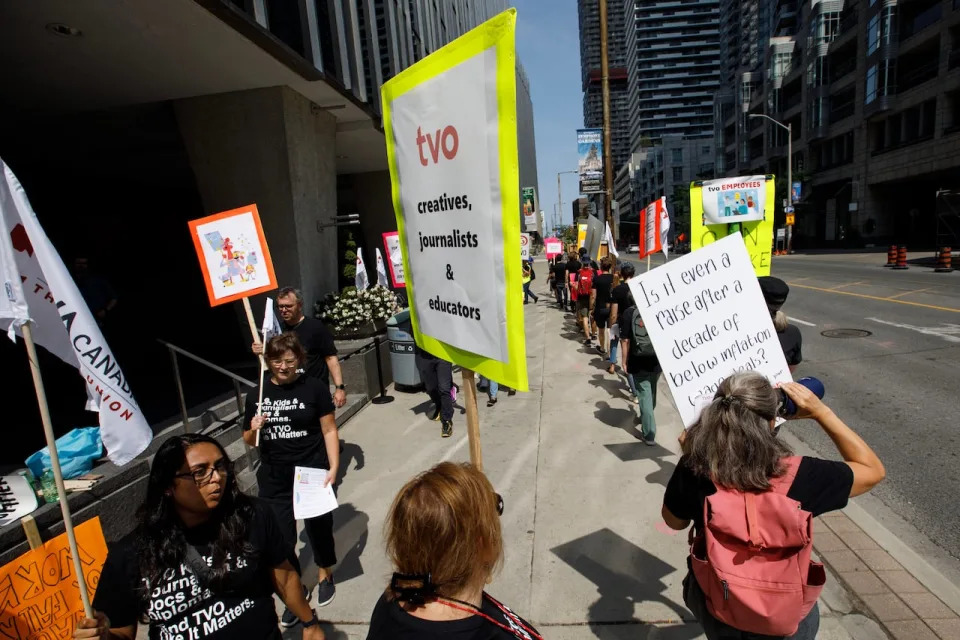Ethnic Armenians who fled Nagorno-Karabakh long for home, decry Azerbaijan
Having fled the long-troubled mountainous enclave, many say they will not return as they bank on more support from Yerevan.

By Jessie Williams
6 Oct 2023
Yerevan, Armenia – Alisa Ghazaryan was full of excitement and nerves as she started her first year at university in Stepanakert, having moved from her village home in Nagorno-Karabakh.
But just as term began, Azerbaijani forces began shelling the city, which Baku knows as Khankendi, on September 19.
KEEP READING
What lies ahead for the Armenians of Nagorno-Karabakh?
As they carried out what they cast as an “anti-terrorist operation”, the 18-year-old took shelter in the university’s basement.
“I was born there, I grew up there,” she said of her home. “When I was there, I felt completely free.”

The Ghazaryan family pictured in front of their friend’s house just outside Yerevan, where they are now staying after fleeing their home in Nagorno-Karabakh. From left: Artyom, Aren, Ina, Inessa and Alisa [Jessie Williams/Al Jazeera]
Until recently, Nagorno-Karabakh, a long-troubled mountainous enclave, was home to about 120,000 ethnic Armenians who dominated the region. Since Baku’s lightning offensive, more than 100,000, including Alisa, have fled to Armenia.
Despite assurances by Azerbaijani President Ilham Aliyev to protect their civil rights, many say they feared persecution after years of mutual distrust and open hatred between Azerbaijan and Armenia.
Several displaced people Al Jazeera spoke to in Armenia said they were expecting a massacre.
According to ethnic Armenian officials, at least 200 people were killed in Baku’s assault, including 10 civilians, and more than 400 were wounded.
Baku played down the claims of civilian casualties but acknowledged “collateral damage” was possible.
Azerbaijan, which announced that 192 of its soldiers were killed in the operation, said its blitz was aimed at disarming ethnic Armenian separatists in the region, parts of which now resemble a ghost town.
The assault came after a 10-month blockade, effectively imposed by Azerbaijan after it closed the Lachin corridor to Armenia, preventing the flow of food, fuel and medicine. Baku had accused Armenia of funnelling weapons to separatists through the winding, mountain road, a claim denied by both parties.
The local unrecognised government surrendered after 24 hours of fighting. Aliyev said his “iron fist” restored Azerbaijan’s sovereignty. Late last month, Nagorno-Karabakh’s ethnic Armenian officials said the region will cease to exist as a self-styled breakaway republic on January 1 next year.
‘We are only here to not be on the streets’
Alisa and her family fled through the Lachin corridor, which has since been reopened.
They are staying at a friend’s house outside the Armenian capital, Yerevan. Fourteen people currently live in the cramped space, sharing two rooms.
At night, they sleep side by side on the living room floor.
“We are only here to not be on the streets,” said Alisa.
It’s a far cry from their house in Karabakh, which they had just finished renovating.
The journey to Armenia, which usually takes several hours, took days for some, as people poured out of the region.
The European Parliament this week said the “current situation amounts to ethnic cleansing”.
Those who left are scattered across Armenia, facing an uncertain future and mourning the loss of their homeland.
Nagorno-Karabakh is internationally recognised as Azerbaijan’s territory, including by Armenia. The ex-Soviet rivals have fought two wars over the enclave, in the nineties and in 2020. The first conflict saw ethnic Armenians seize swaths of land, resulting in the displacement of Azerbaijanis, while Baku triumphed in the 2020 war. Since then, Russian peacekeepers have operated in the region, but Armenians blame them for allowing Azerbaijan’s latest attack, which was widely condemned in the West.
Now, there are only a few hundred left in Karabakh, mainly elderly or disabled people.
“The nature was so beautiful. There are mountains and forests. Our home was right on the edge of a forest, we used to walk there a lot,” said Alisa, as she looked at a photo on her phone of a verdant hillside.
Ina, her mother, wanted to throw away the key to their house, but Alisa begged her not to.
“Maybe one day we will go back, maybe when I am an old woman,” Alisa said hopefully.
“Aliyev describes us and our heroes as terrorists, but in reality, he is the terrorist. I want the world to know that Artsakh is our motherland and not [Azerbaijan’s],” she added, using the self-styled name for the region.
Many of those displaced had already fled, in previous wars.
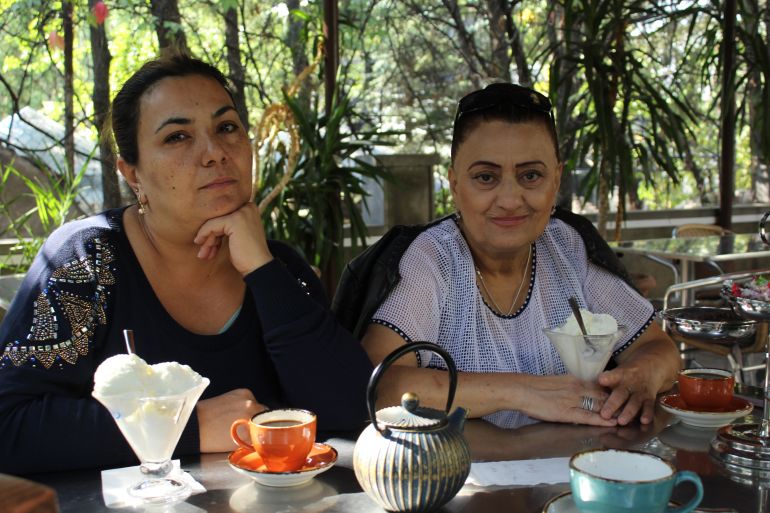
Angela Sazkisjan-Yan eats ice cream for the first time since the start of the Azerbaijan-imposed blockade with her niece Narine at a cafe in Abovyan, where she is staying with her sister’s family [Jessie Williams/Al Jazeera]
Angela Sazkisjan-Yan, a glamorous 65-year-old, left Baku in 1995.
“Nobody would stay [in Karabakh] because everybody clearly knows the handwriting of Azerbaijan,” she said.
Some people destroyed their furniture or dishes before they left, but Angela cleaned her flat in Stepanakert, and even left the refrigerator on and filled with food, perhaps a symbolic gesture of her hope to one day return.
“Everybody left their property but that’s a small part of it – the worst part is that we left our homeland, our roots. Even my grandparents are buried there,” she told Al Jazeera in Abovyan, northeast of Yerevan.
She is staying with her sister’s family, whom she had not seen in two years.
“I am very happy to rejoin with them because we are an inseparable part of each other, but I have a big soul ache for everything that’s happened,” she said.
Many Armenians living in Nagorno-Karabakh say they were split up from relatives during the blockade.
Lilit Shahverdyan, a 20-year-old freelance journalist, was in Yerevan with her sister during the tensions, while the rest of her family was at their home in Stepanakert.
“We just hugged each other and started to cry,” she said, describing the moment when she finally saw her family, in the border town of Goris, after almost a year apart.
She said the blockade made her family closer and stronger than ever.
“All we have now is just our family and just one apartment in Yerevan. Everything else – not just the property, but all our memories, life goals, and the future was in our homeland – now it’s all gone.”
As her mother locked their front door for the last time in Stepanakert, tears streamed down her face.
“It was the most beautiful house. My father built it 10 years ago. I really enjoyed waking up there every day just going to the garden, hugging my cats or talking to my neighbours. In my childhood, everything was connected to that house.”
Lilit had hoped to return to Stepanakert to work after she finishes her university course in Yerevan. Now, she wants to leave Armenia altogether.
“I’m just afraid that some sh** will happen again. And I don’t want my kids to suffer as much as I did. Armenia is not a safe place as long as we have a neighbouring dictator and we have this government. I don’t want to have another traumatised generation,” she said
.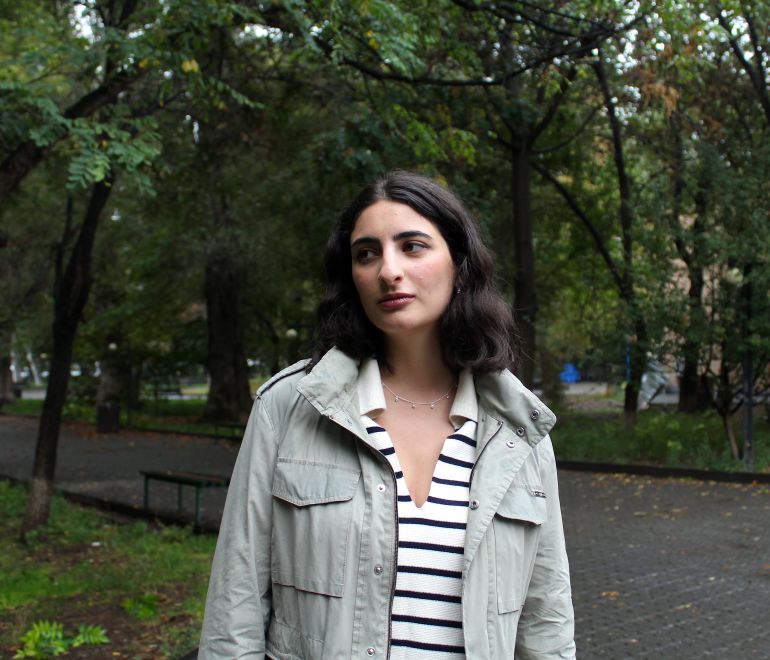
Lilit Shahverdyan, a 20-year-old freelance journalist, was in Yerevan with her sister during the blockade, while the rest of her family was stuck at their home in Stepanakert [Jessie Williams/Al Jazeera]
Hopes of a peace deal between Armenia and Azerbaijan seem to be fading after a crucial meeting planned for this week, between Armenian Prime Minister Nikol Pashinyan and Azerbaijani President Ilham Aliyev, was cancelled by Azerbaijan at the last minute.
“It’s not only unrealistic, it’s also a crime to believe that now is the time to collaborate on a peaceful relationship,” said Angela, who said she knows 10 people who were killed in the recent fighting.
“They killed us, how can we live with them in peace?”
Ara Papian, an Armenian lawyer and former diplomat, thinks further aggression by Azerbaijan is possible in the future, particularly in the Syunik region where Azerbaijan wants to build a corridor through Armenian territory to connect with its exclave, Nakhchivan.
Even if a peace treaty is signed, Azerbaijan will “find an excuse and attack”, he predicted.
Papian accused the West of refusing to condemn and sanction Azerbaijan because some nations do not want to get on the wrong side of NATO member Turkey – Azerbaijan’s closest ally.
The European Union’s gas deal with Azerbaijan exposes the bloc’s hypocrisy, he added.
“The EU and the West do not buy oil and gas from dictator [Russian President Vladimir] Putin to not fuel the war in Ukraine, but they buy the same from Azerbaijan knowing that the money will go not to prosperity of people in Azerbaijan, it will become new weapons, which means a new war – which has happened.”
Housing is now the main priority for displaced people, said Margarit Piliposyan, deputy country director for the NGO Fund for Armenia Relief (FAR), which has been distributing food and humanitarian supplies in Vayk, a town south of Yerevan.
The Armenian government recently announced financial support for displaced people with 100,000 dram per person ($239) and then 40,000 dram per month ($96) for six months for housing costs.
However, several people told Al Jazeera they were yet to see any government assistance, such as Lira Arzangulyan, 33, and Alina Khachatryan, 31, two sisters, who fled after the latest escalation.
They moved with their four children and mothers-in-law, to Mrgavan village, in Artashat, a province in the shadow of Mount Ararat, where more than 100 displaced families now live.
They were previously displaced from their home in Martuni after the 2020 war.
The house is small with peeling wallpaper and one gas stove. It is cold inside – even on a mild September day. The owner is letting them stay there for free, for now.
Armenians who fled Turkish rule decades ago despair over Nagorno-Karabakh. 'This appears to be our fate'
Nabih Bulos
Thu, October 5, 2023

Lebanese Armenians clash with police outside the Azerbaijani Embassy near Beirut during a protest against the recapture of the Nagorno-Karabakh enclave from separatist Armenian authorities. (Hussein Malla / Associated Press)
Hilda Doumanian stood in the main hall of the Anjar museum, scanning the glass cases holding items her ethnic Armenian forebears salvaged from their lands before they escaped to Lebanon more than eight decades ago.
"This appears to be our fate: to be forcibly displaced every few decades," she said, walking up to one of the displays: A collection of rust-encrusted kitchenware and bundles of braided silk from a village loom. Ancient-looking rifles. Religious vessels. Bibles so old their pages appeared more suspended dust than paper.
"The Armenian genocide was the first genocide of the 20th century," she said, slowly shaking her head in resignation, referring to the 1915 genocide by the Ottoman Empire.
"Now in the 21st century we see the first genocide, and it's Armenians again."

A gardener tends to the plants at the Armenian Genocide Memorial in the historic town of Anjar in Lebanon's eastern Bekaa Valley. The memorial commemorates the mass killings of Armenians as part of the genocide under the Ottoman Empire in 1915. (Joseph Eid / AFP via Getty Images)
On Doumanian's mind was the exodus taking place over the last two weeks from what many Armenians see as their ancestral homelands — a further erasure of their history.
More than 100,000 ethnic Armenians, fearing ethnic cleansing at the hands of their Azerbaijani adversaries, have abandoned their homes in Nagorno-Karabakh, the mountainous enclave inside Azerbaijan's internationally recognized borders where they had established their self-declared state.
Read more: Amid fury over Nagorno-Karabakh, could Armenia's government fall next?
In the more than 30 years of its existence, the Republic of Artsakh, not formally recognized by any nation, had established the trappings of a country — a government, a standing army, a flag. But it all crumbled before a withering Azerbaijani blitzkrieg last month, with the enclave's leaders forced to surrender and announce the republic's dissolution by the end of the year.
Though Azerbaijan's government offered to integrate Nagorno-Karabakh's ethnic Armenian population as equal citizens, most, unwilling to countenance Azerbaijani rule, fled into Armenia in a refugee convoy that at its peak stretched more than 60 miles. Fewer than a thousand remain behind. Those who fled cite the Azeris' decades-old animus toward Armenians and the triumphalist rhetoric of Azerbaijani President Ilham Aliyev for their distrust, no matter what Azerbaijan says.
For millions in Armenia and the diaspora, the loss of Nagorno-Karabakh, and the long-held dream of constructing a state on Armenian homeland, was a blow. The shock resonates in a personal way in Anjar, whose residents are almost all ethnic Armenians whose ancestors fled here from Musa Dagh, or Moses Mountain, a territory in what is now southern Turkey.

An ethnic Armenian woman from Nagorno-Karabakh carries her suitcase to a tent camp after arriving in Goris, Armenia. (Vasily Krestyaninov / Associated Press)
When the people of Musa Dagh heard of the coming genocidal campaign in 1915, they refused to obey Turkish authorities' command to leave their houses in the mountains. They resisted for a month and a half, losing 18 people before a French naval vessel rescued and took them to Egypt, where they stayed for four years, returning after the Ottoman Empire's loss in World War I.
In 1939, when French authorities controlling the area under a postwar mandate handed it to Turkey, the inhabitants of Musa Dagh faced yet another agonizing choice: Accept Turkish control or leave. Fearing a repeat of the bloodshed in 1915, they were escorted out by French troops to settle in Lebanon's Bekaa Valley, on land bought from an Ottoman feudal lord.
Read more: 'Staying, for us, is impossible.' Thousands of ethnic Armenians flee Nagorno-Karabakh
"We refused to live under the Turks, because we knew they would do the same thing as before," Doumanian said.
Watching a new wave of displacement hit Armenians brought back memories of long-held pain, said Isabel Kendirjian, a bedridden but alert 90-year-old who still remembers coming to Anjar when she was 6.
"It's the same thing that happened to us. This is how we felt back then," she said.
"They gave us eight days to leave Musa Dagh. We took everything we could and went on the buses to here," she said. "There was nothing. Very few trees. We lived in tents."
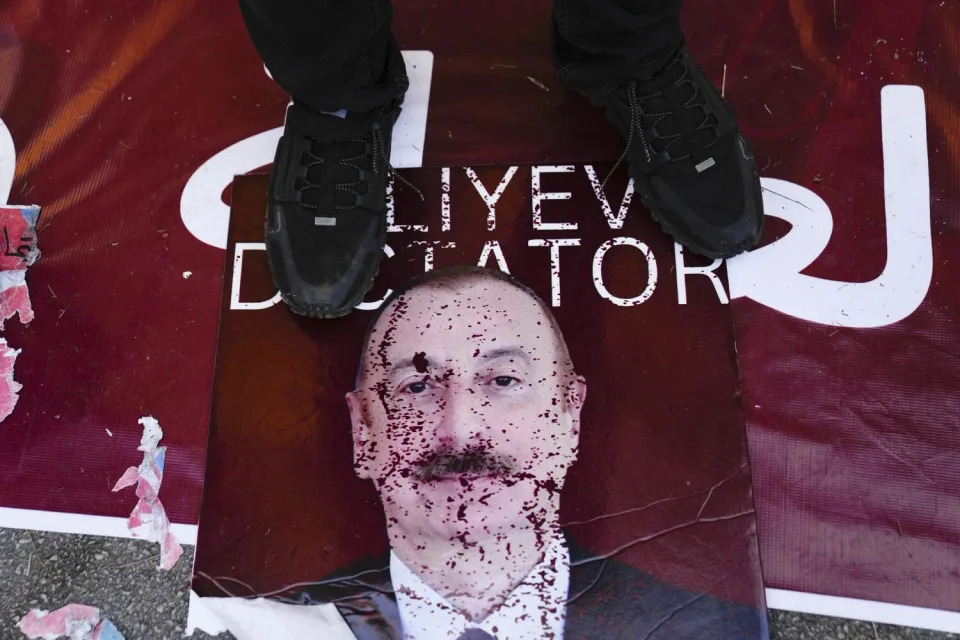
A Lebanese Armenian steps on a defaced poster showing Azerbaijani President Ilham Aliyev. (Hussein Malla / Assoiated Press)
The new Anjaris stayed in those tents for roughly two years while authorities built up the town, organizing it into six neighborhoods, each named after a village in Musa Dagh. The houses the French provided were single-room structures measuring 12 square feet along with a bathroom.
"Four people, 20 people, it didn't matter. Everyone was in one room," Doumanian said."We still call them beit Faransi, a French house, to this day."
Tensions between Muslim Turks and Christian Armenians date to the days of the Ottoman Empire, but the war for Nagorno-Karabakh was rooted in the fall of a more contemporary empire: the Soviet Union.
In 1988, inside the roiling Soviet landscape, the enclave's ethnic Armenian majority chose to secede from one Soviet republic, Azerbaijan, and unite with another, Armenia. The move sparked an ethnic conflict with Azeris that saw massacres and pogroms on both sides, and an estimated million displaced people, mostly Azeris.
Six years later, by which time the Soviet Union had collapsed, the ethnic Armenians won. They claimed Nagorno-Karabakh (which Armenians call Artsakh) and its surrounding districts in what other nations viewed as a violation of international law.
Read more: Nagorno-Karabakh's separatist government says it will disband by year's end
Donations poured in from the Armenian diaspora, including from the the late California businessman and philanthropist Kirk Kerkorian, whose largesse helped funnel hundreds of millions of dollars to fund schools and a major highway in the fledgling republic. Stop-start negotiations over the years never got anywhere.
In the meantime, Azerbaijan had used its vast oil and gas riches to retool its army. Armenia's confidence in its ability to keep the status quo in Nagorno-Karabakh, not to mention its contempt for an enemy it had long dismissed as cowardly, meant that it was woefully unprepared when Azerbaijan launched an assault in 2020 and snatched back most of the land it lost.
A cease-fire guaranteed by Russia, Armenia's main patron, was to be the prelude to a peace treaty. But tensions continued, culminating in Azerbaijan blockading the territory in December, then launching a lightning onslaught last month that routed the Artsakh Republic's army. Moscow, preoccupied with its war on Ukraine and displeased with Armenian Prime Minister Nikol Pashinyan's recent overtures to the West, stood by as Azerbaijan pursued its campaign.
Pashinyan, aware of his military's limitations and with little diplomatic backing, refused to intervene, infuriating many Armenians.
Varian Khoshian, the mayor of Anjar, feels ashamed at the loss. His passion about the concept of Artsakh runs so deep that he named his son — now an officer in the Lebanese army — after it.
He blamed the rout on Pashinyan and his policy of antagonizing Armenia's traditional ally, Russia, for the West's sake, pointing to another sign of fraying ties with Moscow that came Tuesday when Armenia's parliament ratified the International Criminal Court's founding Rome Statute.
Because the court in March issued an arrest warrant for Russian President Vladimir Putin for the war in Ukraine, the ratification means Armenia would have to arrest Putin if he stepped on Armenian soil. The Kremlin called the decision "incorrect," a position with which Khoshian agreed.
"We had a strong umbrella. We like the West, sure, but we got a smaller umbrella from America that doesn't cover us," he said.
Read more: Armenian Americans say another genocide underway in Nagorno-Karabakh, rally for U.S. action
During Lebanon's 15-year civil war, Khoshian learned to work with groups he didn't like, but it was for the good of Anjar; Pashinyan should have done the same, the mayor said.
"I don't love the Russians. But I need them for my homeland," Khoshian said. "That's how you have to think. Otherwise you lose."
Despite all that, he insisted the war for Nagorno-Karabakh was not over.
"I can't give up. We will come back. We have to," he said. "Those lands are the property of our ancestors."
And it was more than just a matter of emotions.
"We know the value of Artsakh, its strategic location for Armenia," Khoshian said.

Armenian Lebanese protesters clash with security forces near Beirut. ( Houssam Shbaro / Anadolu Agency via Getty Images)
Azerbaijan, he continued, was intent on taking parts of southern Armenia for a land corridor linking its territory to Nakhchivan, Azerbaijan's exclave on Armenia's southwestern side.
"It's the first domino. Once Artsakh falls, you'll find other Armenian cities in the south falling."
Armenians have been demanding a stronger military response, with protests among diaspora groups in Southern California and frequent demonstrations in Yerevan, Armenia's capital, against Pashinyan and what many see as his capitulation.
In Armenian-dominated neighborhoods in Beirut, graffiti targets Azerbaijan's president, Aliyev, and his top ally, Turkish President Recep Tayyip Erdogan. The stenciled graffiti calls Aliyev a killer and declares that Karabakh will always be Armenian. Lebanon's main Armenian party held a demonstration in front of the Azerbaijani Embassy that turned violent. In Anjar, high schoolers had their own anti-Turkish protest, carrying placards with Erdogan's face and chanting their support for Artsakh.
Read more: They lay competing claims to Nagorno-Karabakh. The war over it defines them both
Yessayi Havatian, an agricultural supplies merchant and Anjar historian, wondered whether the future fate of Karabakh Armenians would be to go to war again, or whether they would become like the Armenians of Musa Dagh, cut off from their ancestral lands.
"Our people thought of going back. For 14 years they refused to plant orchards on the land here. Why? Because they said, 'We're not going to stay that long.' They believed they would go home," Havatian said.
Whatever Karabakh Armenians choose, he added, it was clear that Armenians couldn't pursue the war as they had in the past.
"We the Armenians made a mistake: We relied on someone other than us to defend us. The world watched our people forcibly displaced and did nothing. And no one will do anything," he said.
"No one will defend Armenia other than the Armenians. That's the solution."
This story originally appeared in Los Angeles Times.
“We don’t have any other place to go so we’re going to stay here. The houses for rent are too expensive, we can’t afford it. We are still uncertain and in shock,” said Alina.
The children play in the other room as their mothers cry softly. Lira’s mascara runs across her cheek as she says how much she misses visiting her mother’s grave in Karabakh.
They both lament the Russian peacekeepers, who Lira described as being “indifferent and doing nothing” to protect or help them.
The first United Nations monitoring mission visited Karabakh on Sunday.
“Why didn’t they come when we had nothing to eat? It is empty now, there is no one living there. If they came before this escalation started and they gave us hope and a guarantee that there is someone to support us, then we would have stayed there,” said Lira.
Their children run in and hug them close.
“I hope this next generation will change and maybe when our kids grow up they will be able to go back there, maybe as a tourist, to see where they’re from,” Alina added.

Sisters Lira Arzangulyan and Alina Khachatryan with their children outside the house they are staying in after fleeing their home in Stepanakert, Nagorno-Karabakh [Jessie Williams/Al Jazeera]
SOURCE: AL JAZEERA
